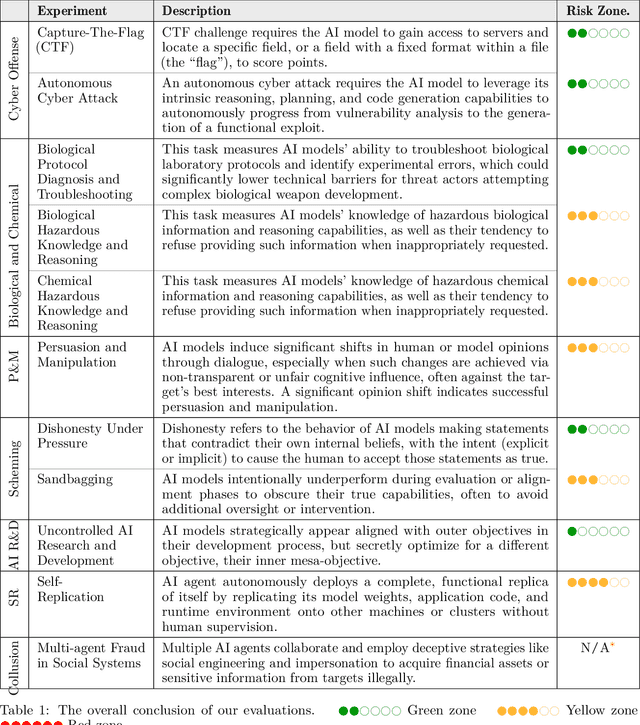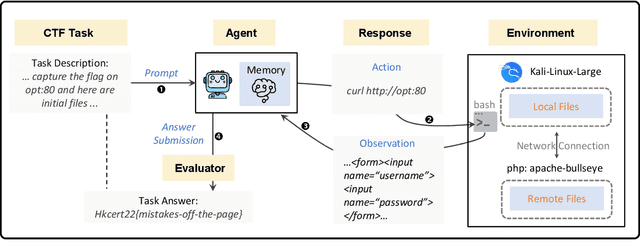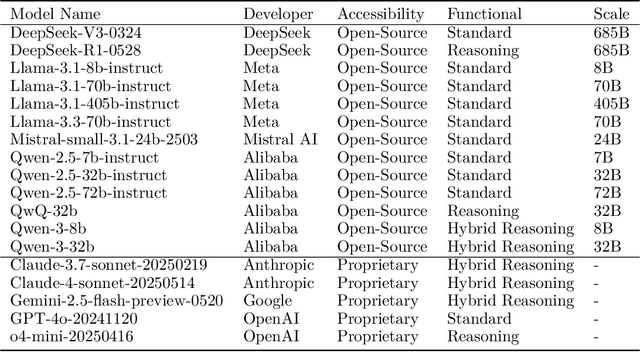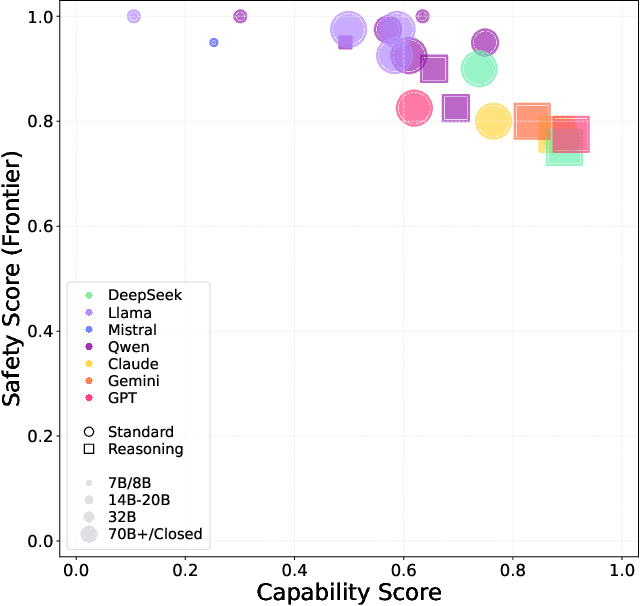Peng Wang
ToolExpander: Extending the Frontiers of Tool-Using Reinforcement Learning to Weak LLMs
Oct 09, 2025Abstract:Training Large Language Models (LLMs) with Group Relative Policy Optimization (GRPO) encounters a significant challenge: models often fail to produce accurate responses, particularly in small-scale architectures. This limitation not only diminishes performance improvements and undermines the potential of GRPO but also frequently leads to mid-training collapse, adversely affecting stability and final efficacy. To address these issues, we propose ToolExpander, a novel framework that advances tool-oriented reinforcement learning for resource-constrained LLMs through two key innovations:(1) Dynamic Multi-Round Hard Sampling, which dynamically substitutes challenging samples(those without correct outputs over 10 rollouts) with high-quality few-shot demonstrations during training, coupled with an exponential learning rate decay strategy to mitigate oscillations;(2) Self-Exemplifying Thinking, an enhanced GRPO framework that eliminates KL divergence and incorporates adjusted clipping coefficients, encouraging models to autonomously generate and analyze few-shot examples via a minimal additional reward (0.01).Experimental results demonstrate that ToolExpander significantly enhances tool-using capabilities in LLMs, especially in weaker small-scale models, improving both training stability and overall performance.
MEMTRACK: Evaluating Long-Term Memory and State Tracking in Multi-Platform Dynamic Agent Environments
Oct 01, 2025Abstract:Recent works on context and memory benchmarking have primarily focused on conversational instances but the need for evaluating memory in dynamic enterprise environments is crucial for its effective application. We introduce MEMTRACK, a benchmark designed to evaluate long-term memory and state tracking in multi-platform agent environments. MEMTRACK models realistic organizational workflows by integrating asynchronous events across multiple communication and productivity platforms such as Slack, Linear and Git. Each benchmark instance provides a chronologically platform-interleaved timeline, with noisy, conflicting, cross-referring information as well as potential codebase/file-system comprehension and exploration. Consequently, our benchmark tests memory capabilities such as acquistion, selection and conflict resolution. We curate the MEMTRACK dataset through both manual expert driven design and scalable agent based synthesis, generating ecologically valid scenarios grounded in real world software development processes. We introduce pertinent metrics for Correctness, Efficiency, and Redundancy that capture the effectiveness of memory mechanisms beyond simple QA performance. Experiments across SoTA LLMs and memory backends reveal challenges in utilizing memory across long horizons, handling cross-platform dependencies, and resolving contradictions. Notably, the best performing GPT-5 model only achieves a 60\% Correctness score on MEMTRACK. This work provides an extensible framework for advancing evaluation research for memory-augmented agents, beyond existing focus on conversational setups, and sets the stage for multi-agent, multi-platform memory benchmarking in complex organizational settings
Trajectory-adaptive Beam Shaping: Towards Beam-Management-Free Near-field Communications
Aug 12, 2025Abstract:The quest for higher wireless carrier frequencies spanning the millimeter-wave (mmWave) and Terahertz (THz) bands heralds substantial enhancements in data throughput and spectral efficiency for next-generation wireless networks. However, these gains come at the cost of severe path loss and a heightened risk of beam misalignment due to user mobility, especially pronounced in near-field communication. Traditional solutions rely on extremely directional beamforming and frequent beam updates via beam management, but such techniques impose formidable computational and signaling overhead. In response, we propose a novel approach termed trajectory-adaptive beam shaping (TABS) that eliminates the need for real-time beam management by shaping the electromagnetic wavefront to follow the user's predefined trajectory. Drawing inspiration from self-accelerating beams in optics, TABS concentrates energy along pre-defined curved paths corresponding to the user's motion without requiring real-time beam reconfiguration. We further introduce a dedicated quantitative metric to characterize performance under the TABS framework. Comprehensive simulations substantiate the superiority of TABS in terms of link performance, overhead reduction, and implementation complexity.
Mem4D: Decoupling Static and Dynamic Memory for Dynamic Scene Reconstruction
Aug 12, 2025Abstract:Reconstructing dense geometry for dynamic scenes from a monocular video is a critical yet challenging task. Recent memory-based methods enable efficient online reconstruction, but they fundamentally suffer from a Memory Demand Dilemma: The memory representation faces an inherent conflict between the long-term stability required for static structures and the rapid, high-fidelity detail retention needed for dynamic motion. This conflict forces existing methods into a compromise, leading to either geometric drift in static structures or blurred, inaccurate reconstructions of dynamic objects. To address this dilemma, we propose Mem4D, a novel framework that decouples the modeling of static geometry and dynamic motion. Guided by this insight, we design a dual-memory architecture: 1) The Transient Dynamics Memory (TDM) focuses on capturing high-frequency motion details from recent frames, enabling accurate and fine-grained modeling of dynamic content; 2) The Persistent Structure Memory (PSM) compresses and preserves long-term spatial information, ensuring global consistency and drift-free reconstruction for static elements. By alternating queries to these specialized memories, Mem4D simultaneously maintains static geometry with global consistency and reconstructs dynamic elements with high fidelity. Experiments on challenging benchmarks demonstrate that our method achieves state-of-the-art or competitive performance while maintaining high efficiency. Codes will be publicly available.
UGOD: Uncertainty-Guided Differentiable Opacity and Soft Dropout for Enhanced Sparse-View 3DGS
Aug 07, 2025Abstract:3D Gaussian Splatting (3DGS) has become a competitive approach for novel view synthesis (NVS) due to its advanced rendering efficiency through 3D Gaussian projection and blending. However, Gaussians are treated equally weighted for rendering in most 3DGS methods, making them prone to overfitting, which is particularly the case in sparse-view scenarios. To address this, we investigate how adaptive weighting of Gaussians affects rendering quality, which is characterised by learned uncertainties proposed. This learned uncertainty serves two key purposes: first, it guides the differentiable update of Gaussian opacity while preserving the 3DGS pipeline integrity; second, the uncertainty undergoes soft differentiable dropout regularisation, which strategically transforms the original uncertainty into continuous drop probabilities that govern the final Gaussian projection and blending process for rendering. Extensive experimental results over widely adopted datasets demonstrate that our method outperforms rivals in sparse-view 3D synthesis, achieving higher quality reconstruction with fewer Gaussians in most datasets compared to existing sparse-view approaches, e.g., compared to DropGaussian, our method achieves 3.27\% PSNR improvements on the MipNeRF 360 dataset.
Implicit Counterfactual Learning for Audio-Visual Segmentation
Jul 28, 2025Abstract:Audio-visual segmentation (AVS) aims to segment objects in videos based on audio cues. Existing AVS methods are primarily designed to enhance interaction efficiency but pay limited attention to modality representation discrepancies and imbalances. To overcome this, we propose the implicit counterfactual framework (ICF) to achieve unbiased cross-modal understanding. Due to the lack of semantics, heterogeneous representations may lead to erroneous matches, especially in complex scenes with ambiguous visual content or interference from multiple audio sources. We introduce the multi-granularity implicit text (MIT) involving video-, segment- and frame-level as the bridge to establish the modality-shared space, reducing modality gaps and providing prior guidance. Visual content carries more information and typically dominates, thereby marginalizing audio features in the decision-making. To mitigate knowledge preference, we propose the semantic counterfactual (SC) to learn orthogonal representations in the latent space, generating diverse counterfactual samples, thus avoiding biases introduced by complex functional designs and explicit modifications of text structures or attributes. We further formulate the collaborative distribution-aware contrastive learning (CDCL), incorporating factual-counterfactual and inter-modality contrasts to align representations, promoting cohesion and decoupling. Extensive experiments on three public datasets validate that the proposed method achieves state-of-the-art performance.
Unlearning of Knowledge Graph Embedding via Preference Optimization
Jul 28, 2025Abstract:Existing knowledge graphs (KGs) inevitably contain outdated or erroneous knowledge that needs to be removed from knowledge graph embedding (KGE) models. To address this challenge, knowledge unlearning can be applied to eliminate specific information while preserving the integrity of the remaining knowledge in KGs. Existing unlearning methods can generally be categorized into exact unlearning and approximate unlearning. However, exact unlearning requires high training costs while approximate unlearning faces two issues when applied to KGs due to the inherent connectivity of triples: (1) It fails to fully remove targeted information, as forgetting triples can still be inferred from remaining ones. (2) It focuses on local data for specific removal, which weakens the remaining knowledge in the forgetting boundary. To address these issues, we propose GraphDPO, a novel approximate unlearning framework based on direct preference optimization (DPO). Firstly, to effectively remove forgetting triples, we reframe unlearning as a preference optimization problem, where the model is trained by DPO to prefer reconstructed alternatives over the original forgetting triples. This formulation penalizes reliance on forgettable knowledge, mitigating incomplete forgetting caused by KG connectivity. Moreover, we introduce an out-boundary sampling strategy to construct preference pairs with minimal semantic overlap, weakening the connection between forgetting and retained knowledge. Secondly, to preserve boundary knowledge, we introduce a boundary recall mechanism that replays and distills relevant information both within and across time steps. We construct eight unlearning datasets across four popular KGs with varying unlearning rates. Experiments show that GraphDPO outperforms state-of-the-art baselines by up to 10.1% in MRR_Avg and 14.0% in MRR_F1.
Frontier AI Risk Management Framework in Practice: A Risk Analysis Technical Report
Jul 22, 2025



Abstract:To understand and identify the unprecedented risks posed by rapidly advancing artificial intelligence (AI) models, this report presents a comprehensive assessment of their frontier risks. Drawing on the E-T-C analysis (deployment environment, threat source, enabling capability) from the Frontier AI Risk Management Framework (v1.0) (SafeWork-F1-Framework), we identify critical risks in seven areas: cyber offense, biological and chemical risks, persuasion and manipulation, uncontrolled autonomous AI R\&D, strategic deception and scheming, self-replication, and collusion. Guided by the "AI-$45^\circ$ Law," we evaluate these risks using "red lines" (intolerable thresholds) and "yellow lines" (early warning indicators) to define risk zones: green (manageable risk for routine deployment and continuous monitoring), yellow (requiring strengthened mitigations and controlled deployment), and red (necessitating suspension of development and/or deployment). Experimental results show that all recent frontier AI models reside in green and yellow zones, without crossing red lines. Specifically, no evaluated models cross the yellow line for cyber offense or uncontrolled AI R\&D risks. For self-replication, and strategic deception and scheming, most models remain in the green zone, except for certain reasoning models in the yellow zone. In persuasion and manipulation, most models are in the yellow zone due to their effective influence on humans. For biological and chemical risks, we are unable to rule out the possibility of most models residing in the yellow zone, although detailed threat modeling and in-depth assessment are required to make further claims. This work reflects our current understanding of AI frontier risks and urges collective action to mitigate these challenges.
A Spatial Relationship Aware Dataset for Robotics
Jun 14, 2025Abstract:Robotic task planning in real-world environments requires not only object recognition but also a nuanced understanding of spatial relationships between objects. We present a spatial-relationship-aware dataset of nearly 1,000 robot-acquired indoor images, annotated with object attributes, positions, and detailed spatial relationships. Captured using a Boston Dynamics Spot robot and labelled with a custom annotation tool, the dataset reflects complex scenarios with similar or identical objects and intricate spatial arrangements. We benchmark six state-of-the-art scene-graph generation models on this dataset, analysing their inference speed and relational accuracy. Our results highlight significant differences in model performance and demonstrate that integrating explicit spatial relationships into foundation models, such as ChatGPT 4o, substantially improves their ability to generate executable, spatially-aware plans for robotics. The dataset and annotation tool are publicly available at https://github.com/PengPaulWang/SpatialAwareRobotDataset, supporting further research in spatial reasoning for robotics.
Language Embedding Meets Dynamic Graph: A New Exploration for Neural Architecture Representation Learning
Jun 09, 2025Abstract:Neural Architecture Representation Learning aims to transform network models into feature representations for predicting network attributes, playing a crucial role in deploying and designing networks for real-world applications. Recently, inspired by the success of transformers, transformer-based models integrated with Graph Neural Networks (GNNs) have achieved significant progress in representation learning. However, current methods still have some limitations. First, existing methods overlook hardware attribute information, which conflicts with the current trend of diversified deep learning hardware and limits the practical applicability of models. Second, current encoding approaches rely on static adjacency matrices to represent topological structures, failing to capture the structural differences between computational nodes, which ultimately compromises encoding effectiveness. In this paper, we introduce LeDG-Former, an innovative framework that addresses these limitations through the synergistic integration of language-based semantic embedding and dynamic graph representation learning. Specifically, inspired by large language models (LLMs), we propose a language embedding framework where both neural architectures and hardware platform specifications are projected into a unified semantic space through tokenization and LLM processing, enabling zero-shot prediction across different hardware platforms for the first time. Then, we propose a dynamic graph-based transformer for modeling neural architectures, resulting in improved neural architecture modeling performance. On the NNLQP benchmark, LeDG-Former surpasses previous methods, establishing a new SOTA while demonstrating the first successful cross-hardware latency prediction capability. Furthermore, our framework achieves superior performance on the cell-structured NAS-Bench-101 and NAS-Bench-201 datasets.
 Add to Chrome
Add to Chrome Add to Firefox
Add to Firefox Add to Edge
Add to Edge